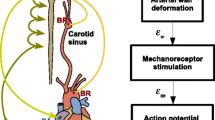Abstract
An approach to mathematical modeling of the baroreceptor that appears suitable for modeling mechanoreceptors in general is discussed. It differs from earlier works reported in the literature in the fact that it divides the baroreceptor into different functional components and attempts to describe mathematically the functioning of each component. The model consists of three first-order ordinary differential equations, one of which is linear; and there are ten free parameters. The ability of the model to fit different sets of experimental data with a single set of parameter values for a given class of inputs is demonstrated.
Similar content being viewed by others
References
Christensen,B.N.: A quantitative study of the carotid sinus baroreceptors in normotensive and hypertensive dogs. Ph.D.Thesis, University of Utah, Salt Lake City, Utah. 1967
Clarke,W. B.: Static and dynamic characteristics of carotid sinus baroreceptors. Ph.D.Thesis. University of Rochester, Rochester, N. Y. 1968
Franz,G. N.: Experimental and theoretical studies of the properties of baroreceptors. Ph. D. Thesis. University of Washington. Seattle. Washington. 1968
Hauss,W.H., Kreuziger,H., Asteroth,H.: Über die Reizung der Pressorezeptoren im Sinus Caroticus beim Hund. Z. Kreislauff. 38, 28–33 (1949)
Katona,P.G., Poitras,J.W., Pantelakis,N., Jensen,E.W., Barnett,G.O.: Deterministic nature of baroreceptor firing. Am. J. Physiol. 215, 1–7 (1968)
King,A.L.: Pressure-volume relation for cylindrical tubes with elastomeric walls: the human aorta. J. Appl. Phys. 17, 501–505 (1946)
Knight,B.W.: Dynamics of encoding in a population of neutrons. J. Gen. Physiol. 59, 734–766 (1972)
Landgren,S.: On the excitation mechanism of carotid sinus baroreceptors. Acta Physiol. Scand. 26, 1–34 (1952)
Landgren,S.: The baroreceptor activity in the carotid sinus nerve and the distensibility of the sinus wall. Acta Physiol. Scand. 26, 35–56 (1952)
Lippold,O.C.J., Nicholls,J.G., Redfearn,J.W.T.: Electrical and mechanical factors in the adaptation of a mammalian muscle spindle. J. Physiol. 153, 209–217 (1960)
Ottoson,D., Shepherd,G.M.: Receptor potentials and impulse generation in the isolated spindle during controlled extension. In: Cold Spring Harbor Symposia on Quantitative Biology New York: Cold Spring Harbor Laboratory of Quantitative Biology, L.I. 1965
Srinivasan,R., Nudelman,H.B.: Modeling the carotid sinus baroreceptor Biophys. J. 12, 1171–1182 (1972)
Zerbst,E., Dittberner,K.H., Kotter,V.: Studies of blood pressure regulation by the use of a baroreceptor analog. Pflügers Arch. 315, 232–249 (1970)
Author information
Authors and Affiliations
Rights and permissions
About this article
Cite this article
Srinivasan, R., Nudelman, H. Theoretical studies on the behavior of carotid sinus baroreceptors. Kybernetik 13, 144–150 (1973). https://doi.org/10.1007/BF00270508
Received:
Issue Date:
DOI: https://doi.org/10.1007/BF00270508




